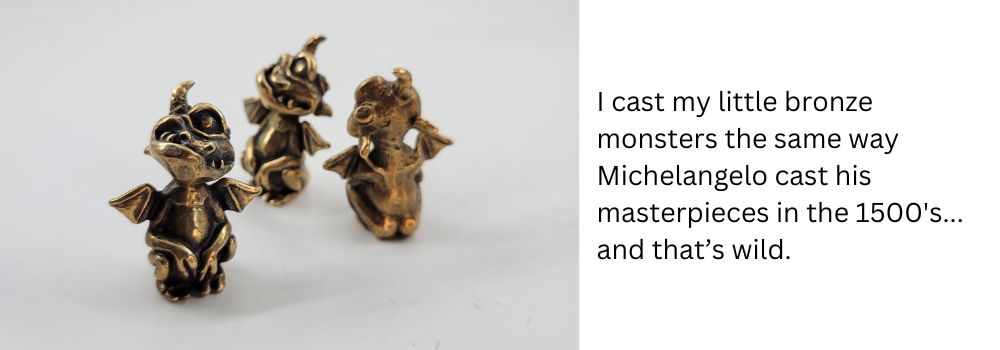Hey there! Today I'm going to get a wee bit technical in hopes of enlightening you on the complexity of my job as a sculptor and jeweler. My entire craft is centered around my casting technique; lost-wax casting. Before we get started, I'm compelled to mention I learned this skill in a college setting, guided by professional artists. Anyone looking to learn lost-wax casting should seek professional guidance, as it is extremely dangerous. With that said, let's get into it!
The lost-wax method, also known as investment casting, is an ancient technique that has been used for centuries. It is a super complex process that requires skill and precision but yields beautiful and unique results that are difficult to accomplish through any other means. I'll do my best to explain the lost-wax casting method in detail and how it is used to create intricate pieces of jewelry as well as towering works of art.
The Origins of Lost-Wax Casting:
The lost-wax casting method has been used since ancient times, and it was originally developed for creating small metal sculptures and jewelry. The process involves creating a wax model, creating an investment mold around the model (for larger sculptures, a ceramic shell is used instead), and then melting the wax away to create a mold. Molten metal is then poured into the mold to create the final piece.
This method has been used by many cultures throughout history, including the Egyptians, Greeks, and Romans. It was frequently used during the Renaissance by iconic artists like Donatello and Michelangelo to create their bronze sculptures.

The Process: Hold onto your hats!
The lost-wax casting process is LONG. It all starts with the creation of a wax model. I do this by hand, the way my ancient predecessors did, but many modern artists use the help of computer-aided design (CAD) software. The wax model is then sprued, which means that it is attached to a wax stem that essentially becomes the flow path of the liquid metal.
Once the wax model has been sprued, the investment mold is made. This involves mixing a heavy plaster and sand slurry and pouring it around the designated design. This mixture is called investment. The investment is filled to the top of the mold, fully encasing the wax item.
Once the investment mold has cured, which takes an hour or more depending on the size of the piece, it is placed in a furnace or kiln upside down and heated to 300 degrees Fahrenheit until the wax melts out through the top and into a collection basin. Alternatively, a steamer can be used to steam the wax out of the molds before they go into the kiln, which reduces the residue left inside the molds from the wax being burned out manually. I have recently adopted this method because burning wax is not only a smelly nuisance but a health hazard!
Once the wax is removed, a perfect mold of the wax model remains, which can later (much later) be filled with molten metal. After wax removal, molds are turned upright and put back into the kiln where the temperature is slowly raised to casting temperature. Casting temperature depends on what is being cast. For example, a mold filled with filigree rings will need to be at a higher casting temperature than a mold of heavy men's rings. The molds ideally should be hot enough that the metal flowing in, flows without cooling too quickly, but not too hot that the metal sloshes around in the mold before it solidifies, which causes imperfections in the surface. Sloshing is not the technical term here, but I think you get the idea.
After the metal has cooled and solidified, the investment mold is broken away to reveal the metal piece inside. The sprues and other supporting structures are then removed using cutters, belt sanders, and low-grit sanding wheels before the piece is cleaned and polished over several days to create a smooth surface. Final finishing techniques include buffing, patination, texture brushing, and waxing.
Advantages:
This casting method offers several advantages over other casting techniques. One of the main advantages is that it allows for the creation of highly detailed and intricate designs. Because the investment mixture is incredibly fine, it picks up texture and detail that would be difficult or impossible to achieve with other casting methods. This is particularly important for jewelry and other decorative objects, where a smooth and polished finish is the goal.
Additionally, lost-wax casting allows for a wide range of metals to be used, including gold, silver, bronze, and brass. This makes it an incredibly versatile technique that can be used to create stunning jewelry and sculpture work of all sizes, finishes, and purities.

Disadvantages:
Despite it being pretty badass in general, lost-wax casting does have its disadvantages. One of the main disadvantages is that it is a time-consuming and labor-intensive process. Each piece must be created by hand, which means that it can take several weeks or even months to complete a single object. If you've ever followed along with me on social media while I'm making a new design, you know this to be true!
Another issue that can arise is expense, especially for larger objects or those made from precious metals. The cost of the investment materials, raw metal, and man hours, make it a more expensive option than other jewelry and sculpture-making techniques. But you get what you pay for, am I right?
Lost-wax casting requires a great deal of skill and is not a technique that can be mastered overnight, it takes years of practice to become proficient in this art form. Investing in a quality handmade item, expertly crafted using this awesome, ancient technique, is not going to be something you regret. Because each piece is handmade, you are truly getting a unique piece of art, created with love and intention. It's an experience you just can't get from a mass-produced product.
I hope you learned something fun today. Thank you for supporting artists and craftspeople like me. Now, off to sculpt something!

1 comment
Fascinating look into your creative process. Very informative & enjoyable.